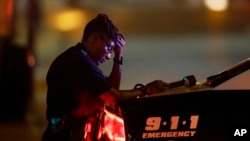The shooting of 12 police officers in Dallas Thursday has created anxiety for law enforcement officers all over Texas and the rest of the nation. In terms of police fatalities - five dead officers - it was the worst incident in the United States since the terrorist attacks on September 11, 2001
The morning after the mass shooting directed at law enforcement officers, Dallas Chief of Police David Brown told reporters, "We are hurting.”
He was speaking mainly on behalf of police officers and their families, especially those who had loved ones killed or wounded, but his words also applied to the citizens of Dallas whose city was briefly turned into what looked like a war zone.
Pain shared by all law enforcement officers
The incident in Dallas resonated with law enforcement officers across the Lone Star state including members of their union, the Combined Law Enforcement Associations of Texas.
In a VOA interview, Executive Director Charley Wilkison said he knows the grief felt by the families of the slain officers.
"They are never going to be whole again," he said, "those families are ripped apart forever and the financial provider is gone.”
Wilkison said the union last year was able to get the Texas legislature to double the death benefit for the family of an officer killed in the line of duty from $250,000 to $500,000. But, he says, officers and their families know that law enforcement in Texas is a risky undertaking.
"Texas has the largest number of fallen officers in the history of America,” he said. "We have the largest number of officers killed in the line of duty of [than] any other state.”
He said more than 1,960 law enforcers have been killed in shootings, automobile accidents and other ways while performing their jobs over the history of the state. He says violence against officers of the law has been a problem since the frontier days, but that lax gun laws today sometimes contribute to their sense of vulnerability.
Police object to open carry law for guns in Texas
"When the gunman started firing and people started running, we saw those people carrying guns start to run," Rawlings said. That led police to believe more people were involved in the attack.
The right of citizens to own guns is protected by the Second Amendment to the U.S. Constitution and the open carrying of guns is legal in Texas. Last year the state legislature extended that right to people who have a concealed handgun permit so that a pistol can be worn publicly in a holster.
The Combined Law Enforcement Associations of Texas opposed that law based on the problems it would create for police, but Wilkison says lawmakers passed it anyway.
"It is not the police organization’s role to create judgments on Second Amendment rights,” he said, "but once you have a critical incident or a mass shooting, it is going to make everything more difficult if you have peaceful, law-abiding citizens openly carrying.”
He notes that in the heat of the moment an officer would have no way of knowing if someone carrying a gun is a threat or not. That same life-or-death judgment must be made by an officer each time he stops someone.
There are more than 400 police killings of civilians in the United States every year, according to Federal Bureau of Investigation reports, but human rights groups and some news organizations have higher figures. What they agree on, however, is that a disproportionate number of the victims are black. Police shootings of black men in Louisiana and Minnesota led to the peaceful Black Lives Matter demonstration in Dallas that was disrupted by the shooting.
Threat to police
Wilkison says citizens need to understand the justifiable fear of the law enforcement officer who often confronts someone in a routine traffic stop who could be armed and dangerous. He said they should comply with the officer’s demands and use legal channels to complain later if needed.
"The rule of law is dependent on a citizen openly surrendering their rights temporarily so that they can go home safely and so they will have that remedy under the law to take care of anything that is done incorrectly,” said Wilkison.
He added that public officials and community leaders also need to address the divisions between races and ethnic groups that contribute to the climate of violence nationwide.














